Fatal Accident Inquiries: review
A thematic review of Fatal Accident Inquiries by the Inspectorate of Prosecution in Scotland.
Investigation of Deaths by Crown Office and Procurator Fiscal Service (COPFS)
Role of COPFS
29. The Lord Advocate is the ministerial head of COPFS and is responsible for the prosecution of crime and the investigation of deaths in Scotland.
30. COPFS aspires to deliver a world leading public prosecution and deaths investigation service which secures justice for the people of Scotland. One of its strategic objectives [13] is that deaths which need further explanation are appropriately and promptly investigated. This includes all sudden, suspicious, unexpected and unexplained deaths and any deaths occurring in circumstances which give rise to serious public concern. The primary purpose of the investigation is to ascertain a cause of death, although there are a number of other aims of the investigation, including:
- To ensure any criminality is discovered and where appropriate, prosecuted;
- To allay public anxieties about particular deaths;
- To alert family members to any genetic causes of death, which may be avoidable; and
- To maintain accurate death statistics.
31. In other parts of the United Kingdom, the coroner investigates deaths and holds inquests. Under the law coroners have two main functions. First, they seek to explain the unexplained. If the death is not from natural causes, if it is unnatural, violent, of unknown cause or occurs in custody, coroners will investigate so that answers are found, for bereaved families and the wider public. Secondly, where appropriate, coroner's report to prevent future deaths.
32. While in some respects the purpose of an inquest by the coroner mirrors that of an FAI in Scotland, we found a number of fundamental differences that precludes any meaningful comparisons between the two systems:
- The coroner service is essentially a local service, run by individual local authorities;
- The type of investigation that can result in an inquest in the coroner's system is much wider and include all suicides and drug and alcohol related deaths and more recently, all deaths of residents in care homes or hospitals that are subject to Deprivation of Liberty Safeguards ( DoLS), usually the elderly suffering from dementia. There are also understandable differences in scale; in 2014, for example, the coroner opened 25,889 inquests [14] compared to 34 FAIs held in Scotland;
- The role of the coroner differs from the procurator fiscal with the coroner presiding over both the investigation and the judicial proceedings;
- Unlike Scotland, a jury may sit with a coroner, if the coroner believes that: the deceased died in custody or state detention and the death was violent or unnatural or the cause of death is unknown and where the death resulted in an act or omission of a police officer, member of a service police force or that the death was caused by accident, poisoning or disease which must be reported to a government department or inspector; and
- The procedures differ with many inquests being opened and adjourned, for a variety of reasons, including allowing criminal investigations to take place.
Statistical Data
Death Reports Received
33. Deaths are most commonly reported to COPFS by hospital doctors, General Practitioners ( GPs) and the police. Chart 1 illustrates that the number of death reports received by COPFS between 2010/11 to 2014/15 has decreased since 2010. In 2010, COPFS received 13,090 reports. This reduced to 9,155 in 2015, a decrease of 30%.
Chart 1 - Death Reports Received [15]
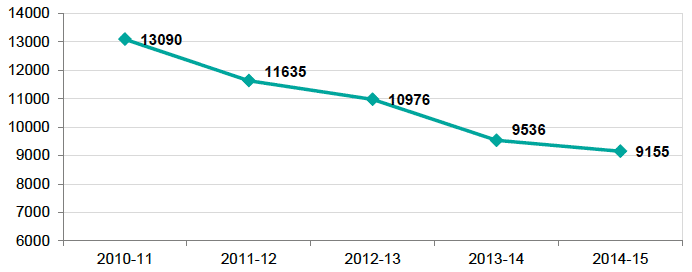
34. Once a death has been reported, COPFS has legal responsibility for the deceased's body, until a cause of death has been established. This is often provided by the procurator fiscal accepting a certificate issued by a doctor certifying the cause of death. [16] Such deaths are categorised as "routine deaths".
35. If the cause of death cannot be certified or if a cause of death is believed to be known, but there are other concerns surrounding the death, further investigation may be required, such as: a post-mortem examination (also known as an autopsy), statements being obtained and liaison with nearest relatives and professionals. Such deaths are categorised as "deaths requiring investigation".
36. Charts 2 and 3 show the number of routine deaths and deaths investigated by COPFS between 2010/11 to 2014/15.
Chart 2 - Routine Deaths [17]
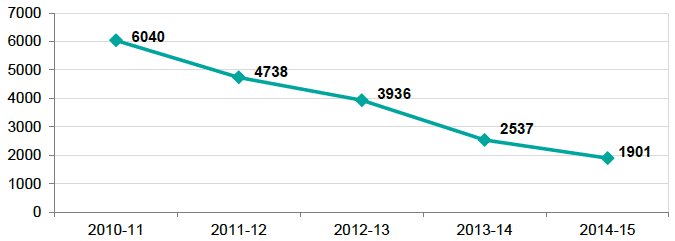
Chart 3 - Deaths Investigated [18]
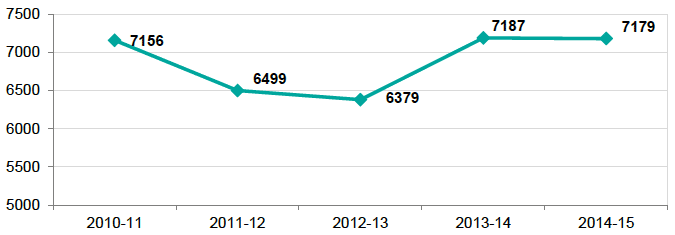
37. Chart 4 shows the number of routine deaths and deaths investigated as a percentage of death reports received. It illustrates a significant increase in the number of deaths investigated in 2013/14 and 2014/15. This reflects:
- An evolution in the public's attitude to death, with a greater expectation of being involved in all important decisions regarding relatives and, in obtaining more information on the circumstances of the death;
- The increasing complexity of such investigations with advances in medical science and more sophisticated means of detecting the cause of accidents; and
- A changing landscape with an increasing number of regulatory and scrutiny bodies that have a duty to investigate a wide spectrum of different types of deaths.
Chart 4 - Deaths Investigated/Routine Deaths as % of Reports Received [19]
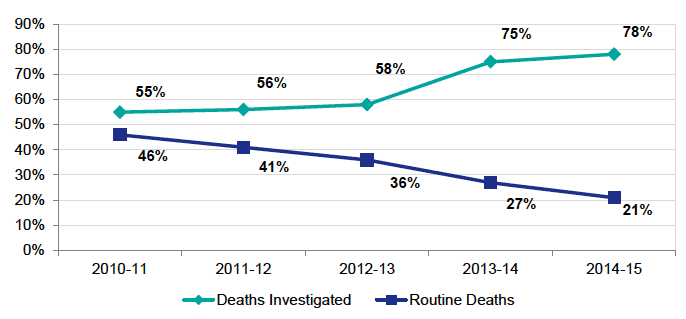
FAIs
38. Many deaths requiring investigation do not result in an FAI. There were 147 FAIs [20] held between 2012/13 and 2014/15. Chart 5 illustrates the spread of FAIs over this period.
Chart 5 - FAIs [21]
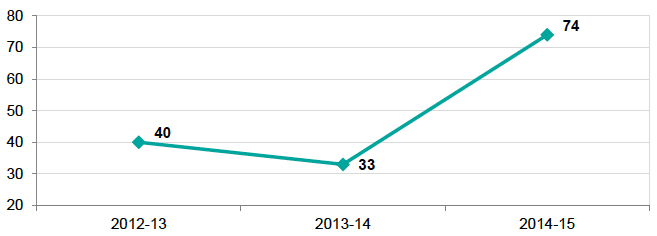
39. Following a reduction in the number of FAIs in 2013/14, the number more than doubled in 2014/15. This corresponds with the sharp increase in deaths investigated in 2013/14. Overall, there has been an 85% increase in the number of FAIs over the three year period. Despite this increase, the number of FAIs is extremely low, representing 0.7% of all deaths investigated. [22]
Type of FAIs
40. Mandatory inquiries must be held when a death occurs as a result of a work-related accident or when the deceased was in legal custody. Discretionary FAIs are held at the discretion of the Lord Advocate if it is in the public interest and if there are lessons that can be learned to prevent deaths occurring in similar circumstances.
Mandatory FAIs
41. There were 129 mandatory FAIs held between 2012/13 and 2014/15; 31 were held in 2012/13, 30 in 2013/14 and 68 in 2014/15, representing a 119% increase over the three year period. Of the 129 mandatory FAIs, 59 concerned deaths that occurred in the course of employment and 70 concerned deaths that occurred while the deceased was in legal custody.
Discretionary FAIs
42. There were 18 discretionary FAIs held over the same period. There were nine discretionary FAIs in 2012/13, three in 2013/14 and six in 2014/15, representing a 33% decrease over the three year period.
43. Chart 6 provides a breakdown of the type of FAIs held.
Chart 6 - Type of FAI 2012 - 2015 [23]
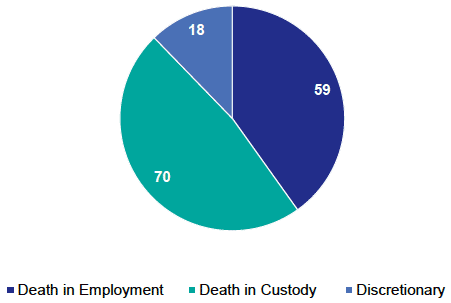
Contact
Email: Carolyn Sharp, carolyn.sharp@gov.scot
There is a problem
Thanks for your feedback